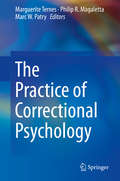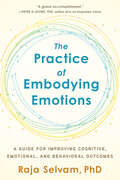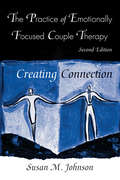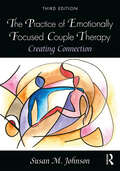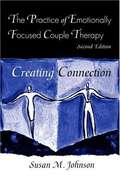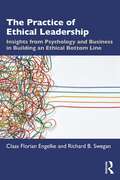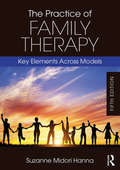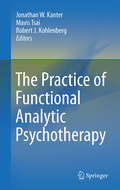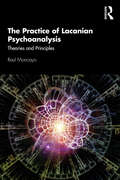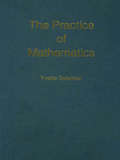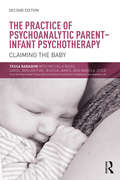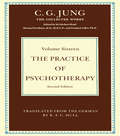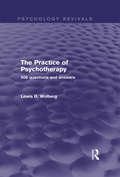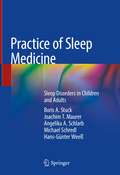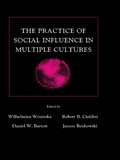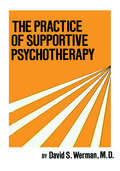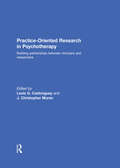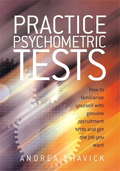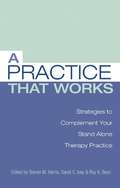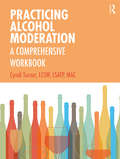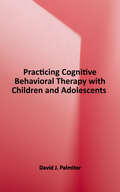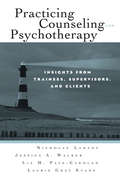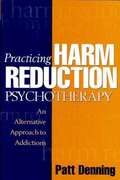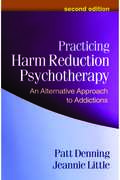- Table View
- List View
The Practice of Correctional Psychology
by Marguerite Ternes Philip R. Magaletta Marc W. PatryThis highly accessible volume tours the competencies and challenges relating to contemporary mental health service delivery in correctional settings. Balancing the general and specific knowledge needed for conducting effective therapy in jails and prisons, leading experts present eclectic theoretical models, current statistics, diagnostic information, and frontline wisdom. Evidence-based practices are detailed for mental health assessment, treatment, and management of inmates, including specialized populations (women, youth) and offenders with specific pathologies (sexual offenders, psychopaths). And readers are reminded that correctional psychology is in an evolutionary state, adapting to the diverse needs of populations and practitioners in the context of reducing further offending. Included in the coverage:· Assessing and treating offenders with mental illness. · Substance use disorders in correctional populations.· Assessing and treating offenders with intellectual disabilities.· Assessing and treating those who have committed sexual offenses.· Self-harm/suicidality in corrections.· Correctional staff: The issue of job stress. The Practice of Correctional Psychology will be of major interest to psychologists, social workers, and master’s level clinicians and students who work in correctional institutions and settings with offenders on parole or probation, as well as other professionals within the correctional system who work directly with offenders, such as probation officers, parole officers, program officers, and corrections officers.
The Practice of Embodying Emotions: A Guide for Improving Cognitive, Emotional, and Behavioral Outcomes
by Raja Selvam&“A grand achievement.&” —Dr. Peter Levine, developer of Somatic Experiencing® and author of Waking the Tiger and In an Unspoken Voice A body-based, science-backed method for regulating behavior, thoughts, and feelings and improving well-being--shown to shorten therapy time and improve emotional outcomes.In the first book on Integral Somatic Psychology™ (ISP), clinical psychologist Dr. Raja Selvam offers a new, complementary approach for building more capacity to tolerate emotions using the body--especially emotions that are difficult or unpleasant.The ISP model shows readers how to expand and regulate emotional experiences in the body to improve different therapeutic outcomes--cognitive, emotional, behavioral, physical, energetic, relational, and even spiritual--in life and in all types of therapies, including other body psychotherapy and somatic psychology approaches. You will learn the physiology of emotions in the brain and body and how to: • Access different types of emotions quickly • Facilitate embodiment and regulation of feelings • Process and heal different traumas and attachment woundsA go-to guide for emotional integration, The Practice of Embodying Emotions is of value in the treatment of a wide range of clinical problems involving difficult emotions--from ordinary life events to psychosomatic or psychophysiological disorders, developmental trauma, prenatal and perinatal trauma, attachment disorders, borderline personality disorder, complex PTSD, collective trauma, and intergenerational trauma--and in improving outcomes and shortening treatment time in different therapies including psychoanalysis, Jungian psychology, and CBT (Cognitive Behavioral Therapy).
The Practice of Emotionally Focused Couple Therapy: Creating Connection
by Susan M. JohnsonSince its original publication in 1996, this volume has been a helpful guide to therapists in the practice of emotionally focused therapy. This second edition addresses the many changes in the field of couples therapy, including updated research results linked to clinical intervention and new information on using EFT to address depression and PTSD. A new section covers the growth of couples therapy as a field and its overall relevance to the mental health field, accompanied by coverage of how recent research into the nature of marital distress is consonant with EFT. Other new features are a section on EFT and feminism, as well as a section on cultural competence for the EFT therapist. Written by a leading authority on emotionally focused couples and marital therapy, this second edition is an up-to-date reference on all aspects of EFT and its uses for mental health professionals.
The Practice of Emotionally Focused Couple Therapy: Creating Connection
by Susan M. JohnsonSince its original publication in 1996, The Practice of Emotionally Focused Couple Therapy has been the definitive guide for couple therapists, supervisors, and students wishing to practice emotionally focused therapy. This cutting-edge third edition addresses recent changes in the field of couple therapy, including updated research results relating to clinical interventions, expanded understandings of emotion regulation, adult attachment and neuroscience, and dynamic EFT applications for a range of issues such as depression, anxiety, sexual disorders, and PTSD. Chapters introduce micro-interventions for use in EFT couple sessions, as well as a systematic presentation of a macro set of interventions called the EFT Tango. Clinical examples are included throughout, bringing the in-session process of change alive, and two case chapters offer in-depth commentaries of Stage 1 and Stage 2 EFT sessions. Written by the leading authority on emotionally focused therapy, this third edition is an essential reference on all aspects of EFT and its uses for mental health professionals in the field of couple and marital therapy.
The Practice of Emotionally Focused Marital Therapy: Creating Connection (2nd Edition)
by Susan M. JohnsonSince its original publication in 1996, this volume has been a helpful guide to therapists in the practice of emotionally focused therapy. This second edition addresses the many changes in the field of couples therapy, including updated research results linked to clinical intervention and new information on using EFT to address depression and PTSD. A new section covers the growth of couples therapy as a field and its overall relevance to the mental health field, accompanied by coverage of how recent research into the nature of marital distress is consonant with EFT. Other new features are a section on EFT and feminism, as well as a section on cultural competence for the EFT therapist. Written by a leading authority on emotionally focused couples and marital therapy, this second edition is an up-to-date reference on all aspects of EFT and its uses for mental health professionals.
The Practice of Ethical Leadership: Insights from Psychology and Business in Building an Ethical Bottom Line
by Claas Florian Engelke Richard B. SweganThis book considers ethics as a practical discipline at the heart of decisions, reasoning, shaping, and ordering organizations. Both engaging and accessible, it offers effective suggestions for selecting and developing ethical leaders and invites readers to self-reflect and understand how to build ethical cultures within their organizations and beyond.Examining the many characteristics of ethical leadership, including love and authenticity, the book uses factual evidence to explore both its positive and negative characteristics. It offers readers an in-depth insight into how ethical decision making can help determine the right thing to do, supported by directly applicable ethical lessons that help leaders become more conscious going forward. The authors provide concrete suggestions for action, as well as ways to develop and understand what is needed to become an ethical leader. Each chapter encourages readers to reflect on their own experiences, as well as engage in discussion with others, and challenge basic assumptions. The book concludes by offering a long-term oriented outlook at future challenges for ethical leaders.Rooted in extensive psychological, philosophical, entrepreneurial, and business experience, The Practice of Ethical Leadership will appeal to leaders, human resource professionals, and Board members across a wide variety of organizations. This book will also benefit academics as well as anyone who is invested in the fields of leadership, management, business, and industrial-organizational Psychology.
The Practice of Family Therapy: Key Elements Across Models (Marital, Couple, and Family Counseling)
by Suzanne Midori HannaNow in its fifth edition, The Practice of Family Therapy comes at a time when traditional approaches to psychotherapy have given way to multidimensional strategies that best serve the needs of diverse groups who are grappling with the many challenges unique to family therapy practice. With expanded coverage of different models, along with new developments in evidence-based and postmodern practices, this integrative textbook bridges the gap between science and systemic/relational approaches, as it guides the reader through each stage of family therapy. Part I lays the groundwork by introducing the first-, second-, and third-generation models of family therapy, teaching the reader to integrate different elements from these models into a systemic structure of practice. Part II explores the practical application of these models, including scripts for specific interventions and rich case examples that highlight how to effectively work with diverse client populations. Students will learn how to make connections between individual symptoms and cutting-edge family practices to respond successfully to cases of substance abuse, trauma, grief, depression, suicide risk, violence, LGBTQ families, and severely mentally ill clients and their families. Also included are study guides for each model and a glossary to review main concepts. Aligned with the Association of Marital and Family Therapy Regulatory Boards’ (AMFTRB) knowledge and content statements, this textbook will be key reading for graduate students who are preparing for the national licensing exam in marriage and family therapy.
The Practice of Functional Analytic Psychotherapy
by Mavis Tsai Robert J. Kohlenberg Jonathan W. KanterSince the earliest years of its development, Functional Analytic Psychotherapy (FAP) has been hailed for its clinical innovation and transformative power with clients across the range of disorders. Building on the foundations of their earlier volumes about this versatile therapy, the editors of The Practice of Functional Analytic Psychotherapy bring together noted clinicians and researchers to explain in depth how FAP can be used in conjunction with a broad spectrum of therapeutic approaches, and with diverse client populations. The hallmarks of the method, including therapist sensitivity and responding to client behavior in the moment, courage, mindfulness, acceptance, and egalitarianism, inform a wide array of interventions and strategies, among them: Integrating FAP with other treatments, including cognitive behavioral therapy, acceptance and commitment therapy, dialectical behavior therapy, behavioral activation, psychodynamic therapies, and feminist therapies. Applying FAP across cultures, nationalities, and ethnicities. Employing FAP with couples. Increasing sensitivity to and effectiveness with sexual minority clients. Modifying FAP for developmentally appropriate use with adolescents. Enhancing a team approach with severely mentally ill patients in institutional settings. Strengthening the power of interpersonal process groups. As a new tool or an enhancement to current practice, these applications of FAP will give therapists an empowering complement to their work. The Practice of Functional Analytic Psychotherapy points to compelling directions in personal growth and change--on both sides of the therapeutic bond.
The Practice of Lacanian Psychoanalysis: Theories and Principles
by Raul MoncayoThe Practice of Lacanian Psychoanalysis lays out an Aristotelian framework to account for the different types of knowing and not-knowing operative in the theory and practice of psychoanalysis. The book proposes a new model for diagnosis, giving preference to fewer over more diagnoses, and seeks to better organize them by distinguishing between structure and surface symptoms. It examines many principles of Lacanian clinical practice, including different types of frames and evidence, the practice of citation and listening, the resistance and desire of the analyst, transference love as a metaphor, the role of negative transference at the end of analysis, and the identification with the sinthome as Lacan's last formulation regarding the end of analysis. The text also suggests that there are three forms of love and hate based on the works of Lacan and Winnicott. Underpinned by extensive practical knowledge of the clinic and case examples for clinicians, analysts, and practicing Lacanian analysts, this book should be of interest to academics, scholars, and clinicians alike.
The Practice of Mathematics
by Yvette SolomonThe psychological description and explanation of how children learn to work with numbers is dominated by the theories of Piaget. Yvette Solomon suggests an alternative approach to the child's conception of number.
The Practice of Psychoanalytic Parent-Infant Psychotherapy: Claiming the Baby
by Tessa Baradon Michela Biseo Carol Broughton Jessica James Angela JoyceThe Practice of Psychoanalytic Parent-Infant Psychotherapy is a comprehensive handbook, addressing the provision of therapeutic help for babies and their parents when their attachment relationship is troubled and a risk is posed to the baby's development. Drawing on clinical and research data from neuroscience, attachment and psychoanalysis, the book presents a clinical treatment approach that is up-to-date, flexible and sophisticated, whilst also being clear and easy to understand. The first section: The theory of psychoanalytic parent infant psychotherapy – offers the reader a theoretical framework for understanding the emotional-interactional environment within which infant development takes place. The second section, The therapeutic process, invites the reader into the consulting room to participate in a detailed examination of the relational process in the clinical encounter. The third section, Clinical papers, provides case material to illustrate the unfolding of the therapeutic process. This new edition draws on evidence from contemporary research, with new material on: Embodied communication between parent and infant and clinician-patient/s Fathers and fathering Engagement of at-risk populations Written by a team of experienced clinicians, writers, teachers and researchers in the field of infant development and psychopathology, The Practice of Psychoanalytic Parent-Infant Psychotherapy will be an essential resource for all professionals working with children and their families, including child psychiatrists, psychoanalysts, psychotherapists, and clinical and developmental psychologists.
The Practice of Psychotherapy: Second Edition (Collected Works of C. G. Jung)
by C.G. JungThe Practice of Psychotherapy brings together Jung's essays on general questions of analytic therapy and dream analysis. It also contains his profoundly interesting parallel between the transference phenomena and alchemical processes. The transference is illustrated and interpreted by means of a set of symbolic pictures, and the bond between psychotherapist and patient is shown to be a function of the kinship libido. Far from being pathological in its effects, kinship libido has an essential role to play in the work of individuation and in establishing an organic society based on the psychic connection of its members with one another and with their own roots.
The Practice of Psychotherapy: 506 Questions and Answers (Psychology Revivals)
by Lewis R. WolbergFreud once humorously remarked that "Anyone who wants to make a living from the treatment of nervous patients must clearly be able to do something to help them". It is amazing how frequently this simple precept is ignored and, when a patient does not get well, how often the failure is attributed to lack of proper motivation, diminutive ego strength, latent schizophrenia, and a multitude of assorted resistances. Difficulties that arise during therapy are not due to a deliberate conspiracy of neglect on the part of the therapist. They usually come about because of obstructive situations that develop in work with patients with which the therapist is unprepared to cope. During his psychiatric career the author, who spent time both teaching and supervising, collected and collated questions from students and graduate therapists who had raised concerns about psychotherapy that related to such obstructive situations. Originally published in 1982, this volume contains both those questions and his answers.
Practice of Sleep Medicine: Sleep Disorders in Children and Adults
by Boris A. Stuck Joachim T. Maurer Angelika A. Schlarb Michael Schredl Hans-Günter WeeßThe book provides an overview of the entire field of sleep medicine, from the basics of sleep physiology to the diagnosis and treatment of specific sleep disorders. It offers a valuable introduction to the field of sleep medicine, but also serves as a reference work on all aspects of clinical practice, including diagnosis, differential diagnosis and treatment of all relevant sleep disorders in children and adults. It starts by presenting sleep physiology and the classification of sleep disorders, and explains in detail all the relevant diagnostic measures in the field. Based on these introductory chapters, it discusses the relevant sleep disorders, including insomnia, sleep-related breathing disorders, hypersomnia, sleep-wake-rhythm disorders, parasomnia, sleep related movement disorders, and secondary sleep disorders, as well as various isolated symptoms. In addition, an entire chapter is dedicated to sleep disorders in children. Drawing on the long-time experience of five board-certified sleep physicians with different professional backgrounds, the book reflects the interdisciplinary nature of sleep medicine. It includes the current international classification systems as well as scoring rules and clinical guidelines. It is intended for physicians and therapists from various specialities, including internal medicine (e.g. pulmonology and cardiology), psychology, psychiatry, neurology, paediatrics, otorhinolaryngology and general medicine who are interested in sleep medicine. It also serves as a textbook in these specialties. To optimize its clinical value, a uniform structure is used for the various chapters, including practical tips, comprehension questions and clinical case presentations.
The Practice of Social influence in Multiple Cultures (Applied Social Research Series)
by Wilhelmina Wosinska Robert B. Cialdini Daniel W. Barrett Janusz ReykowskiThis book provides a diverse collection of studies reporting the effects of social influence processes in multiple cultures at both the universal and culture-specific levels. The book is characterized by three distinct features. First, the social influence process is considered as a ubiquitous and pervasive feature of human interaction. Second, the book represents a multicultural approach which includes both cross-cultural and culture-focused examinations. Third, the book emphasizes practical implications of the research presented. This volume incorporates theory and research stemming from three different approaches to social influence: social influence principles across cultures, social influence and social change across cultures, and culture and moral perspective in the social influence process. Because each of these three parts encompasses a considerable variety of research methodologies, social contexts, and cultures, each is proceeded by an integrative commentary authored by one of the book editors. These essays provide syntheses of the topics and themes within the corresponding sections and within the book as a whole. They also offer critical commentaries on both theoretical and methodological issues, raise suggestions for future research, and focus on practical applications. This book is intended for both scholars interested in cross- and multicultural research into the mechanisms of the social influence process and for the professional whose mission is to make planned changes in a society. Knowledge about the influence process, especially regarding how it works in different cultures and within several cultural groups, facilitates this goal. The practical implications ending each chapter serve as encouraging instructions for such applications.
Practice Of Supportive Psychotherapy
by David S. WermanFirst published in 1989. Routledge is an imprint of Taylor & Francis, an informa company.
Practice-Oriented Research in Psychotherapy: Building partnerships between clinicians and researchers
by Louis G. Castonguay and J. Christopher MuranThe wide gap between science and practice in psychotherapy is due in part to the one-way direction that has mostly defined the connection between researchers and clinicians, with researchers generating empirical knowledge with the hope that practitioners will implement it in their working environment. This traditional approach has not been optimal in addressing the day-to-day concerns of clinicians, or in providing easily generalizable practice guidelines in clinical routine. This book offers an alternative approach to psychotherapy research, based on a partnership between clinicians and researchers in different aspects of the decision, design, implementation, and dissemination of studies conducted in day-to-day practice. More specifically, it describes how to conduct practice-oriented research (POR) by presenting studies and lessons learned (in terms of obstacles faced, strategies used to overcome problems, benefits earned, and general recommendations) by eleven groups of who have been involved in POR in different settings around the world. The book provides tools to help clinicians be active participants in conducting clinically relevant studies, and set the agenda for future research. It seeks to foster collaboration between researchers and practitioners, generating knowledge that can improve our understanding of the process of change and the impact of psychotherapy. This book was originally published as a special issue of Psychotherapy Research.
Practice Psychometric Tests: How To Familiarise Yourself With Genuine Recruitment Tests And Get The Job You Want
by Andrea ShavickFollowing the success of Andrea Shavick's Passing Psychometric Tests and Psychometric Tests for Graduates comes this book, crammed full of even more genuine practice psychometric tests from SHL Group plc, the biggest test publisher in the world. These are the tests used by over 95 per cent of the FTSE 100 companies to select their staff, as do the police, the Civil Service, local authorities, the Armed Forces, the Fire Service, financial institutions, retail companies, the communications industry, the motor industry, the IT industry, the power industry...the list is endless. So if you're looking for a job, you need this book! It includes:* 52 genuine practice tests from SHL Group plc, the biggest test publisher in the world. * 334 questions covering verbal, numerical, abstract and spatial reasoning, mechanical comprehension, fault diagnosis, accuracy and personality, including the popular OPQ 32 personality questionnaire.* Tips on how to improve your performance in every category of test. PLUS valuable advice about: * Online psychometric tests. * Whether or not it's possible to cheat!* How to improve your exam technique, speed up and concentrate. Above all this book will give you the three things you need to pass psychometric tests: information, confidence, and lots and lots of practice.
Practice Psychometric Tests: How to Familiarise Yourself with Genuine Recruitment Tests and Get the Job you Want
by Andrea ShavickFollowing the success of Andrea Shavick's Passing Psychometric Tests and Psychometric Tests for Graduates comes this book, crammed full of even more genuine practice psychometric tests from SHL Group plc, the biggest test publisher in the world. These are the tests used by over 95 per cent of the FTSE 100 companies to select their staff, as do the police, the Civil Service, local authorities, the Armed Forces, the Fire Service, financial institutions, retail companies, the communications industry, the motor industry, the IT industry, the power industry...the list is endless. So if you're looking for a job, you need this book! It includes:* 52 genuine practice tests from SHL Group plc, the biggest test publisher in the world. * 334 questions covering verbal, numerical, abstract and spatial reasoning, mechanical comprehension, fault diagnosis, accuracy and personality, including the popular OPQ 32 personality questionnaire.* Tips on how to improve your performance in every category of test. PLUS valuable advice about: * Online psychometric tests. * Whether or not it's possible to cheat!* How to improve your exam technique, speed up and concentrate. Above all this book will give you the three things you need to pass psychometric tests: information, confidence, and lots and lots of practice.
A Practice that Works: Strategies to Complement Your Stand Alone Therapy Practice
by Roy A. Bean Steven M. Harris David C. IveyIn the advent of managed care and the continuing decline in reimbursement felt across the various disciplines of mental health have had profound impacts upon the quality and quantity of care in the field. As it has become increasingly difficult for a practitioner in private practice to provide a satisfactory level of care while earning a living in the process, many clinicians have become more innovative in the services they offer their clients. This book pulls together a group of mental health professionals who have branched out into new markets and services. A Practice that Works represents an anthology of new knowledge in the field, as chapter contributors describe in revealing detail their own innovative techniques. After first describing the idea behind a strategy such as Wilderness Therapy Programs, the editors discuss the logistics of billing issues pertinent to the strategy and provide practical steps to its implementation, follow-through and development. Finally each chapter includes a 'testimonial' from the editors before considering issues such as any other implications of the strategy, how the strategy can fit into one's larger therapeutic model, and how this new way of thinking has impacted the author's life and practice. This timely book should appeal to professionals in all areas of the mental health fields, and is written in a general style that will not turn any of them away from the innovative lessons to be gleaned from such a unique compilation.
Practicing Alcohol Moderation: A Comprehensive Workbook
by Cyndi TurnerPracticing Alcohol Moderation is designed to be used by clients of behavioral health care providers who have utilized The Clinician’s Guide to Alcohol Moderation. This groundbreaking workbook can be used on its own or in conjunction with therapy, and additionally as a resource for family members whose loved ones are struggling with alcohol. It gives transparent, easy-to-follow, research-based explanations with questionnaires, checklists, quizzes, and worksheets. Each chapter begins with a brief overview and is interspersed with exercises and client experiences, combining research-based information with practical self-assessments, tools, and questions to answer to practice alcohol moderation. Readers can take the Alcohol Moderation Assessment to determine their likelihood of success in practicing alcohol moderation. The book provides the resources to create a personalized Alcohol Moderation Plan and suggests ways to manage its success for clinicians and general audiences alike.
Practicing Cognitive Behavioral Therapy With Children and Adolescents: A Guide for Students and Early Career Professionals
by David J. PalmiterThe euro's life, while only slightly more than a decade long, has been riddled by a series of challenges and crises. The eruption of the Greek crisis in 2010 took European policymakers by surprise and forced them to design responses to a quickly deteriorating situation. Even though Europe has final begun to stabilize, the disparity between the prosperous Northern countries, especially Germany, and the plummeting Southern countries, including Spain and Greece, has exacerbated economic and political problems within the Eurozone. Amidst loud and frequent debates, solutions have been enacted, but the struggles facing this monetary union continue to develop even today. <p><p> The Euro Crisis and Its Aftermath was written to inform readers about the roots of this enduring European crisis and the alternative proposals for ending it. In four parts, Jean Pisani-Ferry explains the origins of the European currency, the build-up of imbalances and oversights that led to the crisis, the choices European policymakers have both addressed and ignored since 2010, and the evolution of the policy agenda and possible options for the future. The book is as much of an informative and analytical history as it is a discussion of solutions for a more prosperous European economy. <p><p> Rather than putting forth and supporting a thesis, Pisani-Ferry helps readers understand the past and present of the euro crisis and form their own opinions about potential solutions. This book is not intended to reach only economists, as time has long passed since European monetary unification was a debate limited to academics. This book is also for the policy makers searching for solutions, citizens of Europe enduring the consequences, and the international community that has felt the effects of an unstable Eurozone.
Practicing Counseling and Psychotherapy: Insights from Trainees, Supervisors and Clients
by Nicholas Ladany Jessica A. Walker Lia M. Pate-Carolan Laurie Gray EvansPracticing Counseling and Psychotherapy: Insights From Trainees, Supervisors, and Clients offers a framework for understanding the counseling and psychotherapy process that can be used in any training program. Clinical examples and discussion questions are included throughout the book, and are based on a large-scale empirical study that qualitatively and quantitatively examines the experiences of trainees, clients, and supervisors. This volume is an excellent resource for those who want an insider's view and conceptualization from the perspectives of psychotherapy trainees, their clients, and their supervisors.
Practicing Harm Reduction Psychotherapy: An Alternative Approach to Addictions
by Patt DenningA clinical psychologist argues for a new model for the treatment of clients with alcohol and substance abuse problems. Inviting clinicians to reexamine their beliefs about substance use as a disease or a moral failing, she states that drugs are used for many different reasons and with different outcomes. Emphasizing treatment of the whole person rather than the drug use alone, she offers concrete treatment strategies based on the idea of reducing harm done by drug use while respecting each client's life choices. Annotation c. Book News, Inc., Portland, OR (booknews.com)
Practicing Harm Reduction Psychotherapy, Second Edition: An Alternative Approach to Addictions
by Patt Denning Jeannie LittleThis acclaimed clinical guide has helped thousands of clinicians put the proven principles of harm reduction into practice with therapy clients who have substance use problems. Written by pioneers in the field, the book shows how to do effective therapeutic work with people still using alcohol or other drugs. It provides clear guidelines for conducting comprehensive assessments, making collaborative treatment decisions, and implementing interventions that combine motivational, cognitive-behavioral, and psychodynamic strategies. The focus is reducing drug-related harm while also addressing co-occurring psychological and emotional difficulties. Detailed clinical illustrations are featured throughout. New to This Edition, Reflects over a decade of research advances and the tremendous growth of harm reduction clinical practice and training. Section on applications, with chapters on community-based settings, harm reduction groups, and working with families and friends. Chapters on biological and psychodynamic aspects of treatment. Expanded discussions of trauma, cultural sensitivity, and ethics. Supplemental resources and training materials at the authors' website.
